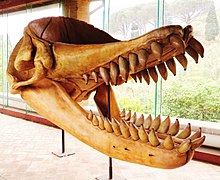
Back لوياثان (حوت) Arabic Livyatan Czech Livyatan German لویاتان ملویلی Persian Livyatan French לווייתן מלווילי HE Livyatan Hungarian Livyatan ID リヴィアタン・メルビレイ Japanese 리비아탄 멜빌레이 Korean
| Livyatan | |
|---|---|

| |
| Cast of skull at the Natural History Museum of the University of Pisa | |
| Scientific classification | |
| Domain: | Eukaryota |
| Kingdom: | Animalia |
| Phylum: | Chordata |
| Class: | Mammalia |
| Order: | Artiodactyla |
| Infraorder: | Cetacea |
| Superfamily: | Physeteroidea |
| Family: | incertae sedis |
| Genus: | †Livyatan Lambert et al., 2010 |
| Species: | †L. melvillei
|
| Binomial name | |
| †Livyatan melvillei Lambert et al., 2010
| |
| Synonyms[1] | |
| |
Livyatan is an extinct genus of macroraptorial sperm whale containing one known species: L. melvillei. The genus name was inspired by the biblical sea monster Leviathan, and the species name by Herman Melville, the author of the famous novel Moby-Dick about a white bull sperm whale. Herman Melville often referred to whales as "Leviathans" in his book. It is mainly known from the Pisco Formation of Peru during the Tortonian stage of the Miocene epoch, about 9.9–8.9 million years ago (mya); however, finds of isolated teeth from other locations such as Chile, Argentina, United States (California), South Africa and Australia imply that either it or a close relative survived into the Pliocene, around 5 mya, and may have had a global presence. It was a member of a group of macroraptorial sperm whales (or "raptorial sperm whales") and was probably an apex predator, preying on whales, seals and so forth. Characteristically of raptorial sperm whales, Livyatan had functional, enamel-coated teeth on the upper and lower jaws, as well as several features suitable for hunting large prey.
Livyatan's total length has been estimated to be about 13.5–17.5 m (44–57 ft), almost similar to that of the modern sperm whale (Physeter macrocephalus), making it one of the largest predators known to have existed. The teeth of Livyatan measured 36.2 cm (1.19 ft), and are the largest biting teeth of any known animal, excluding tusks. It is distinguished from the other raptorial sperm whales by the basin on the skull spanning the length of the snout. The spermaceti organ contained in that basin is thought to have been used in echolocation and communication, or for ramming prey and other sperm whales. The whale may have interacted with the large extinct shark megalodon (Otodus megalodon), competing with it for a similar food source. Its extinction was probably caused by a cooling event at the end of the Miocene period causing a reduction in food populations. The geological formation where the whale has been found has also preserved a large assemblage of marine life, such as sharks and marine mammals.
Cite error: There are <ref group=lower-alpha> tags or {{efn}} templates on this page, but the references will not show without a {{reflist|group=lower-alpha}} template or {{notelist}} template (see the help page).
© MMXXIII Rich X Search. We shall prevail. All rights reserved. Rich X Search